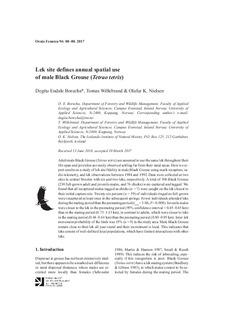Lek site defines annual spatial use of male Black Grouse (Tetrao tetrix)
Journal article, Peer reviewed
Permanent lenke
http://hdl.handle.net/11250/2448495Utgivelsesdato
2017Metadata
Vis full innførselSamlinger
Originalversjon
Ornis Fennica. 2017, 94 .Sammendrag
Adult male Black Grouse (
Tetrao tetrix
) are assumed to use the same lek throughout their
life-span and juveniles are rarely observed settling far from their natal areas. Here we re-
port results on a study of lek site fidelity in male Black Grouse using mark-recapture, ra-
dio-telemetry, and lek observations between 1984 and 1992. Data were collected at two
sites in central Sweden with six and two lek
s, respectively. A total of 306 Black Grouse
(230 full-grown adult and juvenile males, and 76 chicks) were captured and tagged. We
found that all recaptured males tagged as chicks (
n
= 7) were caught on the lek closest to
their initial capture site. Twenty-six percent (
n
= 59) of individuals ringed as full-grown
were recaptured at least once in the subseque
nt springs. Fewer individuals attended leks
during the mating period than the premating period (
t
(15)
= 3.06,
P
= 0.008). Juvenile males
were closer to the lek in the premating period (95% confidence interval = 0.45–0.65 km)
than in the mating period (0.73–1.13 km), in contrast to adults, which were closer to leks
in the mating period (0.44–0.61 km) than the premating period (0.80–0.95 km). Inter-lek
movement probability of the birds was 15% (
n
= 9) in the study area. Male Black Grouse
remain close to their lek all year round and their recruitment is local. This indicates that
leks consist of well-defined local populations
, which have limited interactions with other
leks.
